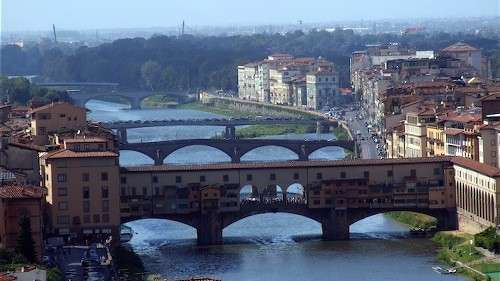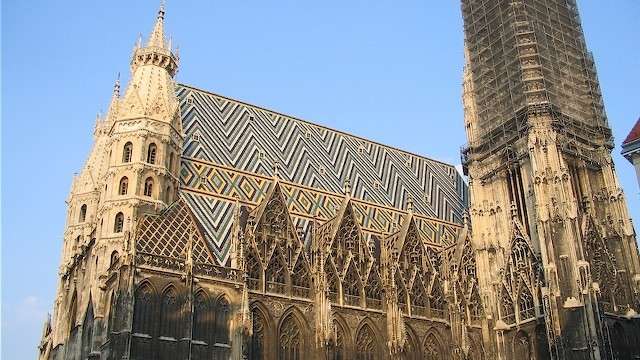Père Lachaise Cemetery
The most visited cemetery in the world Père Lachaise Cemetery (Cimetière du Père-Lachaise) is the largest cemetery in the city of Paris.
Père Lachaise Cemetery was opened on 21 May 1804. Napoleon, who had been proclaimed Emperor by the Senate three days earlier, had declared during the Consulate that “Every citizen has the right to be buried regardless of race or religion“. The cemetery takes its name from the confessor to Louis XIV, Père François de la Chaise (1624–1709).
Presently there are more than 1 million bodies buried there, and many more in the columbarium, which holds the remains of those who had requested cremation.
The rules to be buried in a Paris cemetery are rather strict: people may be buried in one of these cemeteries if they die in the French capital city or if they lived there.
The cemetery manages to squeeze an increasing number of bodies into a finite and crowded space by combining the remains of multiple family members in the same grave. At Père Lachaise, it is not uncommon to reopen a grave after a body has decomposed and inter another coffin. Some family mausoleums or multi-family tombs contain dozens of bodies.
During relatively recent times, the Père Lachaise has adopted a standard practice of issuing 30-year leases on grave sites, so that if a lease is not renewed by a family, the remains can be removed, space made for a new grave, and the overall deterioration of the cemetery minimised. Abandoned remains are boxed, tagged and moved to Aux Morts ossuary, in Père Lachaise cemetery. Plots can be bought in perpetuity or for 50, 30 or 10 years, the last being the least expensive option. Even for the case of mausoleums and chapels, coffins are most of the time below ground.
Graves to See In Père Lachaise Cemetery
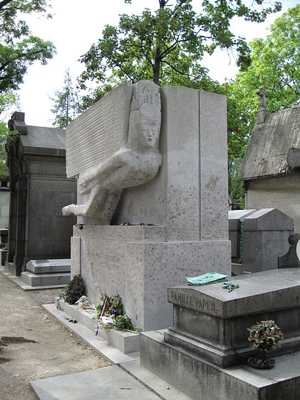
Oscar Wilde
Thousands of lipstick marks cover the façade of Oscar Wilde’s tomb, as well as flowers, letters and various other bizarre items and trinkets. The tomb, designed by Jacob Epstein in 1914, features the sculpture ‘Modernist Angel’, which is roughly three meters tall.
A certain amount of controversy surrounded the construction of the tomb, with fans unimpressed by the choice of the sculptor, critics insisting Wilde did not merit such a tomb and Wilde’s literary executor trying to work out who the generous benefactor, who made the whole tomb possible, might be.
Wilde’s is probably the most famous tomb in Père Lachaise. Wilde died in France after leaving England to avoid the shame of his conviction for ‘gross indecency.’ His legendary is said to have extended to his death bed, where he is supposed to have made a witty remark – ‘My wallpaper and I are fighting a duel to the death. One or other of us has to go.’
Wilde’s tomb, with an angel displaying its genitalia, was defaced soon after its erection. Today the monument stands covered in lipstick where women kiss the stone, proving the grave’s popularity. Engraved on the tomb is a verse from the Ballad of Reading Gaol by Wilde:
And alien tears will fill for him
Pity’s long-broken urn,
For his mourners will be outcast men,
And outcasts always mourn.
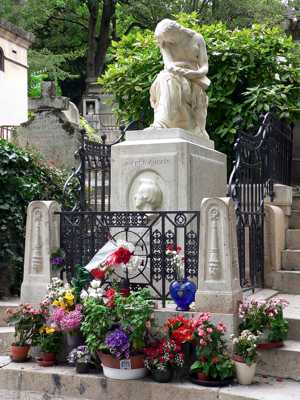
Chopin
Chopin’s remains are buried here save for his heart, which was returned to his home town in Warsaw. A statue of Eugène, the muse of music sits atop the gravestone, mourning over a broken lyre.
Chopin is the master of the solo piano, grew up in Warsaw but settled in France in later life. It was in Paris that Chopin died, after a long battle with lung disease. His body was buried in Père Lachaise, though his heart was removed for burial in his homeland.

Édith Piaf
With a life story to rival most soap operas, Piaf’s life began and ended in Paris. Despite suffering severe poverty and destitution as a child, Piaf’s talent for singing was her ticket off the streets and into bars and clubs (including the hangouts of Nazi officers for whom she was obliged to perform) and eventually onto the global music scene. Piaf’s career was short and plagued with misfortune.
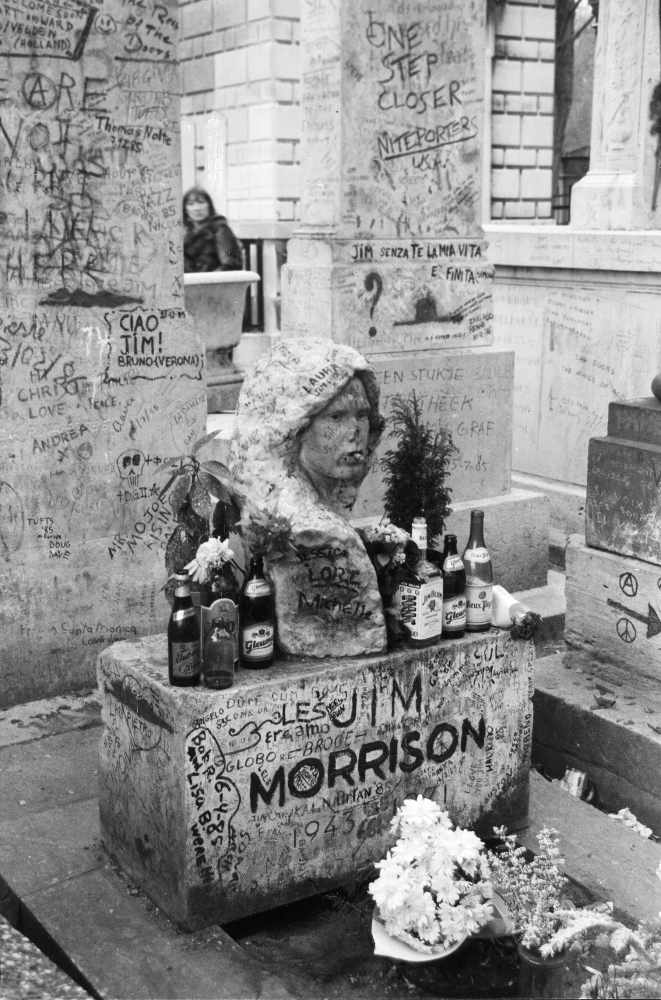
Jim Morrison
Morrison, lead singer of The Doors, has a simple tomb, but it is one of the most popular in the cemetery. After Morrison died in 1971, of a suspected drug overdose in Paris, he was buried in an unmarked grave in Père Lachaise.
When the decision was made to mark the grave with a simple sign, it was stolen. After the same thing happened to a bust of the musician, a guard was installed to ensure that visitors did not deface or destroy the grave in any way.
The stone bears the Greek inscription: ΚΑΤΑ ΤΟΝ ΔΑΙΜΟΝΑ ΕΑΥΤΟΥ, literally meaning “according to his own daimon”.
The Greeks called that distant voice within us, that higher source of inspiration and enlightenment, a person’s daimon, interpreted as “true to his own spirit”.
Today, pilgrims to the tomb of The Doors‘ front man leave messages, flowers or poems in their wake, making it one of the most visited graves in the cemetery. This will be my fourth visit Jim.

Abelard and Heloise
The remains of these two ill-fated lovers were moved to Père Lachaise in 1817 by Josephine Bonaparte, who was so moved by the story of their romance that she became intimately concerned with the state of their bodies.
The story goes that 12th-century theologian Abelard was employed to instruct intellectually-gifted Heloise, the niece of the Canon of Paris. Despite their 20-year age difference and the strict laws of the time, both fell in love and Heloise became pregnant with Abelard’s child. They fled to Brittany and married but were soon discovered by Heloise’s uncle. Heloise was forced to become a nun and poor Abelard was forcibly castrated and took the Holy Orders. The two never saw each other again, but wrote letters to each other for the remainder of their lives.

Marcel Proust
Marcel Proust’s most famous novel A la Recherche du Temps Perdu has infiltrated Western culture indefinitely, with its Madeleine extract repeated again and again to show the link between sense and memory. His work was largely published posthumously as his life was cut short by pneumonia at the age of 51. His grave is simple and small, and thus often passed-by, but the effect this author had on culture and philosophical research can not be overstated.
Moliere
Buried under his stage name (nobody would recognize Jean-Baptiste Poquelin anyway), Moliere’s tomb is among the most visited in the cemetery. He is famous for his plays such as Tartuffe, The Misanthrope, and The Bourgeois Gentleman. His actual burial in Pere Lachaise was surrounded by controversy too, as he was an actor as well as a playwright. Traditionally actors were not allowed to be buried in consecrated ground. However, a loophole was found and he was eventually buried among infants who died before baptism.
Isadora Duncan
Unfortunately strangled when her scarf caught in the wheel of her car, Isadora Duncan was always fond of Paris, where she eventually settled, especially after her American citizenship was revoked following some hedonistic behaviour or other. Widely renowned for her focus on emotion and expression in the realm of dance, which was in contrast to traditional ballet forms, her contribution to the world of performing arts lives on to this day.

Honoré de Balzac
Author of the great novel series La Comédie Humaine, Balzac loved to walk among the tombs in Pere Lachaise. If he was alive to appreciate it he would surely be delighted to be buried amongst his heroes today. He is buried alongside his wife, with a bust of himself (made by David d’Angers) and a figure of a feathered pen with a copy of La Comédie Humaine below.

Mur des Fédérés
This wall marks the deaths of 147 combatants (men, women, and children) of the Paris Commune who were forced to stand in front of the wall and were shot, falling into an open trench in 1871. The wall became particularly important for French socialists, who saw it as a symbol of the French people’s struggle towards liberty. The wall is, in comparison to the rest of the cemetery, quite simple, but acts nevertheless as a sobering reminder of political and ideological conflicts around the world.
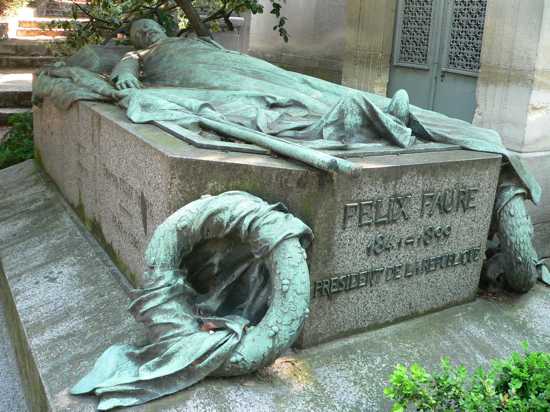
Félix Faure
Félix Faure was president of France from 1895 until his death in 1899. His presidency is famous for the Franco-Russian alliance and the Dreyfus affair. It is his death, however, that has spread Faure’s name outside of France. Faure died after suffering an apoplectic episode whilst in bed with his mistress, Marguerite Steinheil, with rumours surfacing that he died while receiving oral sex from her.
While the actual event is, of course, shrouded in gloom, it has become an infamous example of political scandal. His tomb shows him draped in cloth (the flag?), though some have seen it as him reclining in his death bed. George Clemenceau gave Faure the epitaph ‘Il voulait être Céwar, il ne fut sue Pompée.’ You can translate that as either ‘He wanted to be Caesar, he ended being Pompey’ or ‘He wanted to be Caesar, he ended being pumped.’
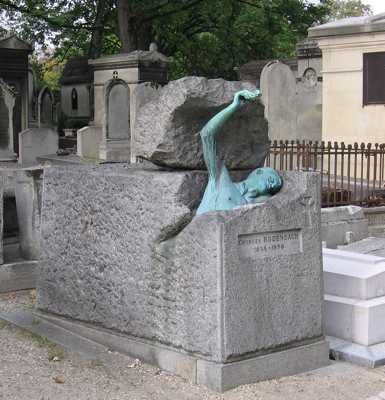
Georges Rodenbach
Georges Rodenbach, the Belgian writer and poet of the 19th century, is perhaps most famous today for his novel Bruges-la-Morte. This work was later turned into the opera Die Tote Stadt. His tomb shows a bronze figure breaking out of the grave. If death cannot stop him, perhaps he deserves some attention.
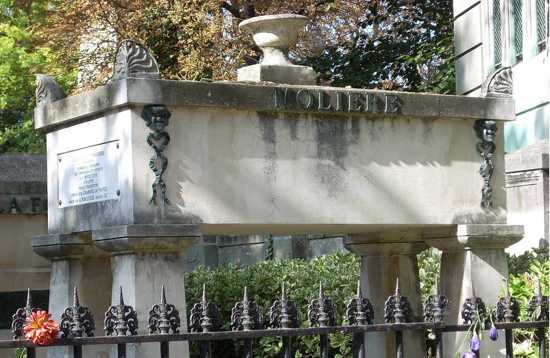
Molière
Jean-Baptiste Poquelin, better known as Molière, was one of the greatest comic playwrights of all time. Molière suffered for many years from TB. Despite his illness, Molière insisted on performing in his play Le Malade Imaginaire (Also known as The Hypochondriac). In this play a man suffers terribly from illnesses he does not have.
Molière, on the other hand, was suffering terribly from a real illness. While playing the part of the hypochondriac, he succumbed to a coughing fit, and died later at home. Since Molière was an actor, he was not allowed to be buried in consecrated ground, and only the intervention of the king allowed him burial amongst the unbaptised infants. His remains were transferred in 1817 to this tomb in Père Lachaise.
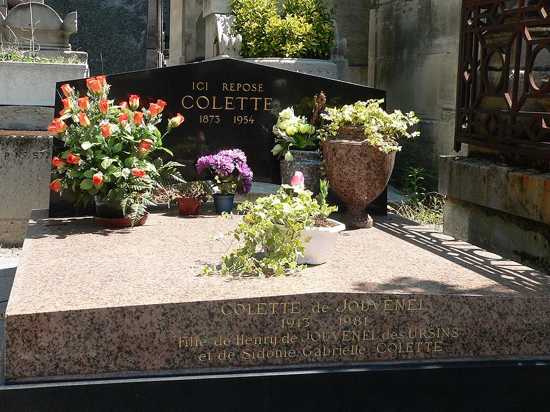
Colette
Sidonie-Gabrielle Colette, known simply as Colette, was best known for her novel Gigi, her other writings, and her unorthodox love life. She was the first woman in France to receive a state funeral. Her grave is always decorated with flowers. Locals say that this is because the cats which lurk behind all the tombs replace the flowers on her grave daily.
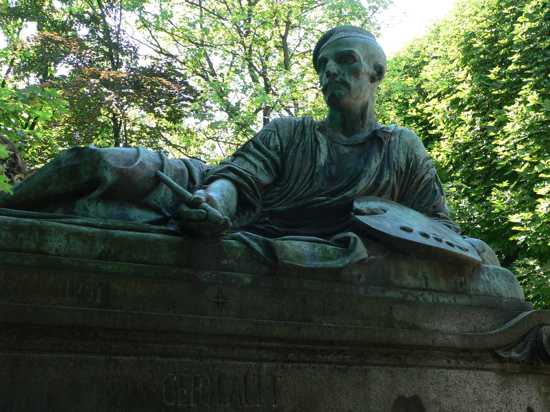
Théodore Géricault
Géricault lived for only thirty-two years, but he left behind a body of famous paintings which influenced the Romantic Movement. His ‘Raft of the Medusa’ is one of the most visited paintings in the Louvre. I included Géricault in a previous list for his somewhat chilling painting of severed heads.
His tomb in Père Lachaise is a masterpiece all of its own. The monument is topped by a reclining bronze of Géricault with his paintbrush and palette. The statue shows Géricault as vital and alive and not the thin spectre that the TB which killed him had turned him into. On the side of the tomb, there is a bronze version of The Raft of the Medusa, so that everyone passing may see his genius.
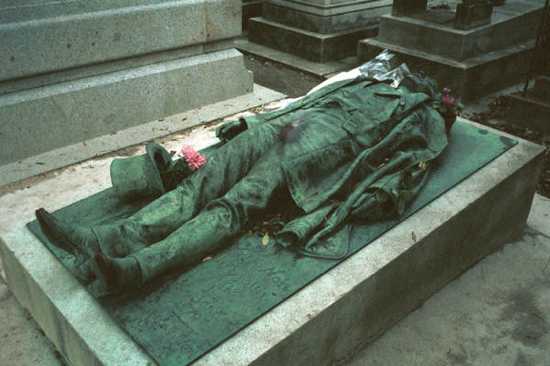
Victor Noir
Victor Noir is more famous for his death and his grave than for his life. Noir was born Yvan Salmon but adopted a pen name when he moved to Paris to take up journalism.
When a cousin of the Emperor challenged the owner of the newspaper for which Noir worked to a duel, Noir was sent, as one of the seconds, to arrange the details of the duel. When the Prince referred to Noir and a companion as ‘menials’, a slap was exchanged, with either Noir striking the Prince or being struck by him, and the Prince then shot Noir dead. To mark Noir’s grave, a bronze statue of the man lying supine as if just shot, his hat lying beside him, was erected.
This statue has since become something of a fertility symbol. Due to the naturalistic style of the sculpture, there is a rather prominent fold in Noir’s trousers which make him appear to be aroused. It is said that by rubbing this area and leaving a flower in Noir’s hat, a woman is guaranteed a husband within the year. While the rest of the statue is covered with verdigris, Noir’s crotch gleams, proving the popularity of this particular myth.

